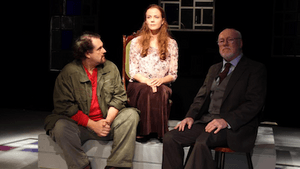Stay in the Loop
BSR publishes on a weekly schedule, with an email newsletter every Wednesday and Thursday morning. There’s no paywall, and subscribing is always free.
Seeing and understanding
Irish Heritage Theatre presents Brian Friel's 'Molly Sweeney'

One of the under-appreciated aspects of theater production is having the right space for a play. It's an advantage of companies that don't have their own homes, like the Irish Heritage Theatre (IHT): they produce large-cast Irish classics on larger stages, and then put an intimate play like Brian Friel's Molly Sweeney in the 55-seat Walnut Street Theatre Studio 5, which feels just right for this three-actor collection of monologues.
Molly Sweeney receives a smart and heartfelt performance from IHT and director Peggy Mecham. Kirsten Quinn plays the title role, a woman in Friel's fictional town of Ballybeg, where many of his plays (most famously, Dancing at Lughnasa) are set. Molly has "no useful sight," we soon learn, but copes well with near blindness.
Seeing and understanding
Everything changes when husband Frank (Ethan Lipkin) and Doctor Rice (Michael P. Toner) urge Molly into experimental sight-restoring surgery. In direct address to the audience, they tell the story of Molly's surgery and its aftermath. "She would still have to learn how to see," Rice explains. "She would have to create a whole new world."
Friel's lilting prose and likeable characters draw us into a tale that makes the hopes of all three palpable, even as we detect deeper troubles. Reveries about the difference between seeing and understanding — how the former means the latter — reveal how they overlook what's right in front of them. Point of view concerns Friel as well; he relates the removal of Molly's bandages from Frank's perspective rather than Molly's. This choice is fascinating, and most telling.
Toner, a beloved local Irish theater specialist for over four decades, is superb as Rice, maintaining a posh accent until drink and regret force his Irish brogue to the surface. Lipkin excels as a more realistic, human-sized character than he usually plays, revealing Frank's charms and failings.
The play, however, focuses on Quinn's Molly, who contradicts any notion that a blind person is somehow lost or weak. Though apparently ready for the adventure of changing from a touch-based relationship with the world to a sight-based one, she discovers it's not so easy. Friel explains the science behind her difficult transition in relatable terms. She asks, "How do they know what they're taking away from me?" But she may not know either. Quinn plays Molly's blindness with subtle mastery, and makes a character often taken for granted by those around her rich and complex.
A shot of whiskey
Mecham's production keeps our focus on the characters. Teddy Mosneau’s set, three chairs with three stained-glass windows hanging behind them, are subtly changed during Act Two. Eric Baker's lighting generates moody shadows. In an effort to provide more stage action, characters sometimes intrude on each other's space in ways that seem contrary to the script, or at least not helpful. We don't need Molly to act out what Frank recalls about her later and alone. The stillness, and each character's isolation, shouldn't be compromised.
Most effective, though, is the unusual and fun decision to offer a shot of Irish whiskey before the play. I took it, after some hesitation, and later realized that since Molly Sweeney plunges us into a different reality existing within our own, a little traditional impairment (or inspiration, or insight), a symbolic something to alter one's typical playgoing state of mind, sets the right tone for this beautifully ethereal play.
And that's not the booze talking.
What, When, Where
Molly Sweeney. By Brian Friel, Peggy Mecham directed. Through Oct. 15, 2016 at the Walnut Street Theatre Studio 5, 825 Walnut St., Philadelphia. Irishheritagetheatre.org.
Sign up for our newsletter
All of the week's new articles, all in one place. Sign up for the free weekly BSR newsletters, and don't miss a conversation.
 Mark Cofta
Mark Cofta